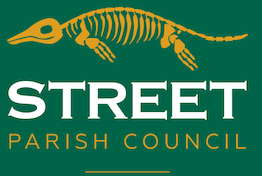HISTORY OF ICHTHYOSAUR FOSSIL EMBLEM OF STREET
For over 100 years the residents of Street have been aware that their village is associated with the image of a reptilian skeleton but many do not know where the association comes from. Around 210 million years ago at the start of the Jurassic period, Street was under a shallow subtropical sea. In the sea lived dolphin-like reptiles called ichthyosaurs which ate fish and squidlike belemnites. They gave birth to live young in the water. During the same time dinosaurs were living on land.
When the ichthyosaurs died their bodies sometimes sank to the seabed where they were buried in the mud. Over millions of years the mud turned into blue lias limestone. Blue lias was quarried in Street where many of the houses were built of it. Blue lias from Street was especially good for paving and kerbs so may be seen in numerous places many miles away. It was during the 19th and 20th centuries that the fossil skeletons of ichthyosaurs were collected from the blue lias including many from quarries in Street.
When Street Urban District Council was created in 1894 it chose to use the ichthyosaur on its seal. Since local authority reorganization in 1974 Street Parish Council has continued to use the ichthyosaur emblem. The ichthyosaur depicted on Street’s mug which celebrated 2000 AD was a faithful copy from the 1894 seal. A number of versions of the image can be seen on signs, litter bins, noticeboards etc. around Street.
On 16th November 2021 the Parish Council agreed to adopt a new updated logo incorporating an ichthyosaur which can be seen at the top of the home page. This will be used on all Council property, publicity etc. and will be instantly recognizable as relating to Street Parish Council.

